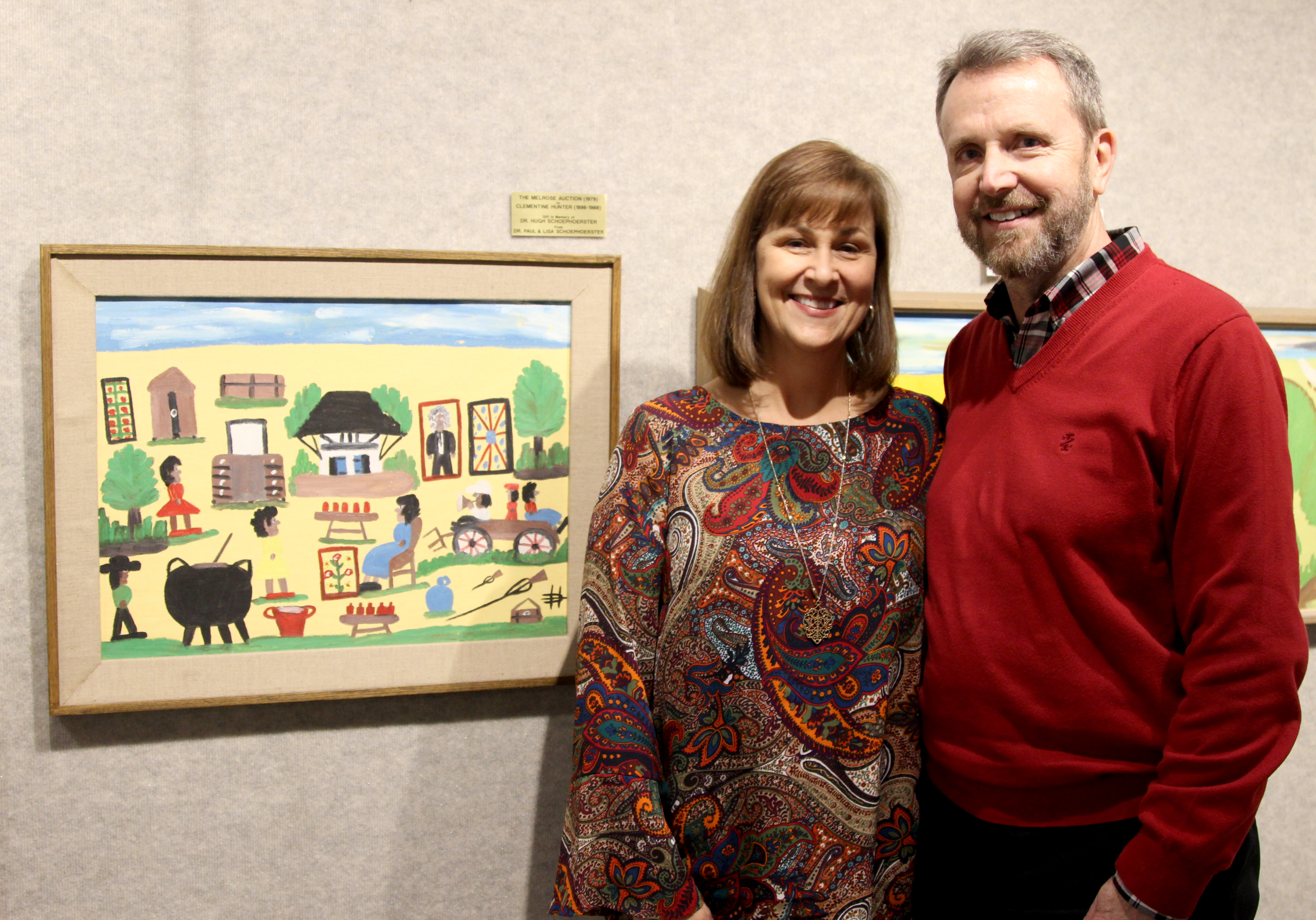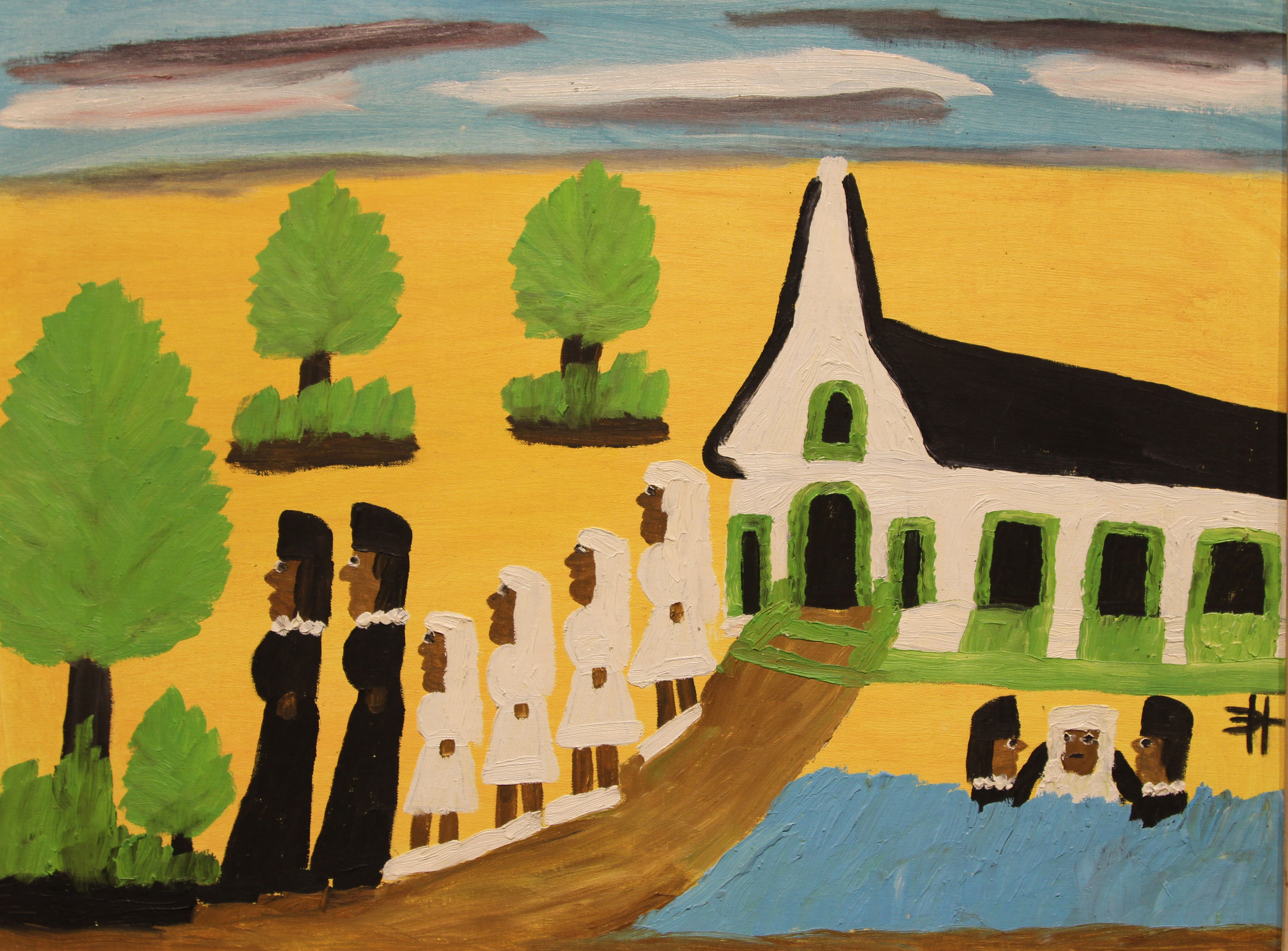
When the collection of paintings by the Louisiana folk artist was first on display on the Central Methodist University campus in February and March of 1996, it was Dr. Hugh Schoephoerster who brought the bright, colorful paintings to the Gallery. More than two decades later, Hugh’s son and long-time Fayette resident Paul, and wife Lisa, have loaned a portion of the collection to the latest exhibit, “Afro-American Images in Art.” In doing so, the Schoephoersters hope to spread the love of Hunter’s work, and appreciation of art as a whole, to a new generation.
“I think her art is very relatable,” Paul said of Hunter, whose self-taught art skills have grown more renowned in the American folk art community over the last 50 years. “It’s so simple, it’s so naïve that it’s very relatable, especially to kids. . . [They] can see this and they know what’s going on. They love the bright colors, they can relate to it, and I think that’s an important point of art.”
That simplistic aspect of the paintings, which depicts mostly plantation life in the early 20th century, was a catalyst for the elder Dr. Schoephoerster to teach young students about art. In the family’s home state of Minnesota, Hugh worked with a program called Young Audiences to bring the collection to various schools, where the students would then learn about the artist and later put on their own art exhibit.
“Dad always, being an educator, thought it imperative that Clementine’s work got around,” said Paul, who added that in addition to the school program, his father brought the collection to various colleges and universities throughout the Midwest.
It’s reasonable that Hugh would feel that way about Hunter’s art, considering how he came to collect it in the first place. As a professor and co-author of the Houghton-Mifflin Reading series, Hugh traveled across the country to promote and educate. At one time in the mid- ‘70s, he received a life-changing invitation from Dr. Mildred Bailey, then the head of the education department at Northwestern State University in Natchitoches, Louisiana.
“Mildred was very good friends with Clementine and was one of the original friends of Clementine that got her exposed and got her on the map,” said Paul. He noted that his father had never heard of Hunter before being invited to teach summer classes at Northwestern. But during his weeks in Louisiana, Bailey introduced him to the woman who would become his favorite artist.
“It was one of those ‘The rest is history’ moments,” Paul said. “He absolutely fell in love with her, fell in love with her story and that whole area.”
Hunter’s story and the area of Natchitoches are heavily intertwined, as she spent almost the entirety of her 101 years at Melrose Plantation. Her art is even visible in the background throughout the film Steel Magnolias, which released the year after Hunter’s death in 1988 and was set in Natchitoches parish.
 With the help of the film and other collectors and art enthusiasts, Hunter’s work spread throughout the country and the world, but the Schoephoerster home was always one of the places where a large collection could be found. After his first meeting with Hunter, Paul says, his father would visit each summer, always coming home with more and more paintings and other works of art.
With the help of the film and other collectors and art enthusiasts, Hunter’s work spread throughout the country and the world, but the Schoephoerster home was always one of the places where a large collection could be found. After his first meeting with Hunter, Paul says, his father would visit each summer, always coming home with more and more paintings and other works of art.
“It got to the point where our house was adorned with these colorful Clementine paintings,” said Paul, who was around middle school-aged when the paintings first started to arrive. “He probably had a hundred pieces or more in total.”
“When I first met him, he had this huge family room, and the walls were just covered,” said Lisa. “I remember walking in and going, ‘Wow.’”
Being surrounded by so much art throughout his youth – his father collected works by other American artists as well, including Jacqueline Rochester, Frederic Remington, and Norman Rockwell – gave Paul an appreciation for art that he has carried throughout the rest of his life. From maintaining the portion of the Hunter works left to him upon his father’s death in 2000 to supporting the Fayette theatre scene, fine arts have been a big part of the physician’s life outside of work.
“Growing up with Dad and his love of art and having art all around us, it instilled that in us,” Paul said of himself and his siblings. “And it carried on when [Lisa and I] got to Fayette.”
The Fayette connection through Paul and Lisa was what brought the Hunter collection to Ashby-Hodge in 1996, as the couple became friends with Dr. Joe Geist and the late Tom Yancey, the gallery’s co-founder.
“We did a big show,” recalled Geist. “His father was so generous and brought down, I think, 30 pieces for that show.”

It seems fitting, given the history of that first show and Hugh’s desire to educate through art, that Hunter’s paintings have once again found a temporary home at CMU, where they can once more achieve that goal.
“Education was a very important part of Dad’s philosophy and desire of owning art,” said Paul. “Not just to store it and look at it, but to share it.”
Hunter’s work, as well as the rest of the “Afro-American Images” collection and “Fleeting Moments” by Erin Price, can be viewed at the Ashby-Hodge Gallery from 1:30 to 4:30 p.m. every Sunday, Tuesday, Wednesday, and Thursday (excluding holidays and spring break). Contact Denise Haskamp to schedule tours at 660-248-6304 or dhaskamp@centralmethodist.edu.